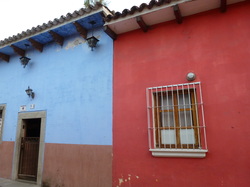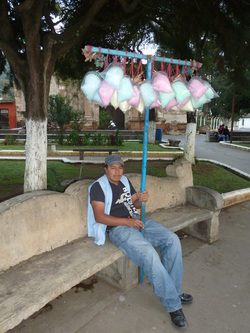|
I promised to post some photos of Antigua's Semana Santa, Holy Week celebration. I have already written a blog about this celebration, but it is nearly impossible to imagine without photos. Thousands of Antiguenens participate in this celebration, both walking with the processions and creating alfombras, carpets in the street. Some of the alfombras are shown in the slideshow below. They are made of pine needles and flowers, fruits and vegetables or colored sand applied to stencils. The designs are watered to keep them in place and fresh. The processions carrying Jesus and Mary walk through these beautiful carpets which are then destroyed by their passage. During the first days of the holy week, children are major participants, with the boys and men wearing purple robes and the girls wearing white. The women mostly wear black. A part of being in the procession involves carrying the elaborate statutes which tell the story of Jesus's last week. The men carry Jesus and the women carry Mary. The heaviest of these floats weighs 2 tons. Moving these enormous scenes, especially around corners, involves tremendous care and coordination of effort. All processions are accompanied by more incense (copal) than I have ever inhaled in my life, partly due to the enthusiastic boys swinging the incense censors.
1 Comment
 It was easy to catch a shuttle to Antiqua from the airport in Guatemala City. And yet at first it was hard to pay much attention to Antigua itself, even though it is a UNESCO World Heritage Site. But I found Antigua’s natural setting so captivating that my first impression was being held in a ring of lush green mountains. As a resident of both Hawaii and of the Pacific Northwest, I’m no stranger to vistas which include awe inspiring mountains and even active volcanos. But Guatemala. the land of “eternal spring,”is unique. Cradled in the Panchoy Valley,12,325 foot inactive Agua Volcan rises to a dramatic peak. While Agua Volcan appears to be the highest mountain in the vicinity, in fact Acatenago to the west, at 13,900 feet, is even higher. Next to Acatenango are the active Fuego Volcanos. Like Hawaii’s Kilauea, Volcan Pacaya emits slow flowing lava and it is possible to get quite near the lava with a reasonable uphill trek. I have met travelers who have even roasted marshmallows over the hot spot at the top of Pacaya! I settled for a shorter excursion on my first day though, content with climbing to the roof of my hotel to more fully enjoy the 360 degre view and also to look down on the tile roofs and the inner courtyards of the city. The grand arch of Santa Catalina and the ornate church of La Merced dominate the skyline of the city. The bells of Antiqua's churches punctuate the mornings and evenings. From the roof it is also possible to see evidence of the city's colonial architecture as well as the remaining ruins from the 1773 earthquakes. Across the cobblestone street from my hotel room I hear the soft and regular sound of hands patting. Two women wearing Mayan skirts (cortes) and blouses (huipils) slap the maza, the cornmeal dough, into flat round tortillas which they place on the brazier to cook. These tortillas are made fresh every day by women in the doorways of tiendas and then sold, warm, to the surrounding families to stuff like tacos with frijoles and rice or to fold and dip into savory bowls of soup.  The streets are lined with dwellings and shops, each demarcated by a different color of paint. So that looking down streets one sees what appears to be a continuous wall, painted blue, rose, red, yellow, orange and peach -- interrupted by recessed windows or long metal or wooden doors or the open entryways of tiendas. The tiendas are small, specialized local businesses -- small food stores and laundries, coffeeshops, hotels, bakeries, language schools, restaurants, internet cafes, candy sellers, motorcycle repair shops and venders of office supplies and photocopies.  The smell of freshly made bread, pan, is an irresistible lure into one of the many panaderias, bakeries. But there is more than fresh bread inside. Flaky pastries with sweet layers of frosting; croissants plain or with ham; empanadas with apple, pineapple or strawberry filling and chocolate cupcakes or donuts fill the cases. Antiqua is also well known for her pastielles or cakes. These line the pastry cases like glistening gems , covered with chocolate glaze from local cacoa beans and accented with slices of fresh oranges. Other cakes are topped with sugar- glazed kiwis, bananas, limes and strawberries all arranged in an artistic bouquet of color on the white frosting. Many of the cakes are sliced into individual pieces which are sold separately. Of course, in the name of research for my tours, I must try one (a day)!  In the morning the soft scratch of brooms made of long lengths of straw is the daily sound of workers and shop keepers sweeping sidewalks and the footpaths of the parks. Antiqua has many pleasant and well-maintained parks which are well -used by both residents and visitors. In fact, my favorite post- lunch past time is to read for a half hour in my nearby park. Cotton candy vendors roam the parks carrying trees of pink and blue spun sugar enclosed in clear bags. Young lovers kiss without pause or self-consciousness as workers with machetes weed the flowers and ornamental plants. Groups of men meet and talk over newspapers. Women sell roasted corn, chile relleno sandwiches, peeled pineapple and papaya topped with a spoonful of chile while children play with brightly colored balls. Foreign students emerge from the nearby language schools to smoke cigarettes on the benches and clear their minds of wriggling conjugations of verbos while Guatemaltecos pass on the street, the white sticks of lollipops protruding from their mouths. Sometimes I am serenaded by a group of primary school children wearing pleated skirts, dark pants and white shirts under school uniform sweaters. A few of the children carry drums while others tote metal instruments shaped like lyres, but with metal bars like xylophones, played by striking the metal keys with mallets. Their teacher leads them in “Are you sleeping, brother Juan?” and “Twinkle, twinkle, little star.” The lyres make a sweet chiming sound, like hundreds of little bells. Antigua is a city with mixed population of Mayan indigenous peoples, Ladinos and also foreigners who come to learn Spanish or to explore Guatemala, a county which remains "off the beaten track" of international tourism despite it's rich cultural heritage. The people here are welcoming and curious about where I have come from and why I am in Guatemala. Every day I exchange greetings with nearly everyone I pass on the street, "Hola, Buenos Dias," we each say with a smile. Antigua is a wonderful base for my exploration of Guatemala, not only because the city herself holds endless treasures but also because Antigua is well located for exploring the surrounding pueblos including the home of the giant kites of Sumpango~! And yes, for learning more Spanish, tambien. |
Louise "Luisa" Wisechild, PhDI first visited Guatemala in 1995 as a member of the Vashon Island sister city delgation to Santiago de Atitlan, Guatemala. Archives
October 2023
Categories
All
|


 RSS Feed
RSS Feed

